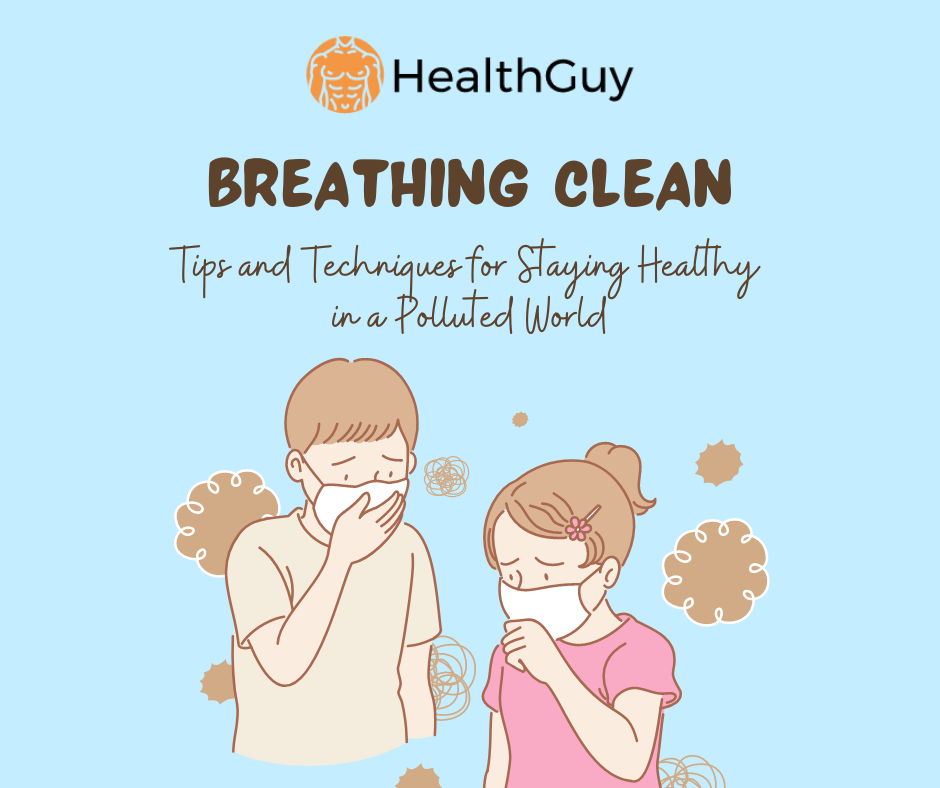
Breathing Clean: Tips and Techniques for Staying Healthy in a Polluted World
Air pollution is a growing concern worldwide, and its impact on respiratory health cannot be overstated. According to the World Health Organization (WHO), air pollution is responsible for the deaths of 7 million people every year. In this article, we’ll discuss the impact of air pollution on respiratory health, and ways to reduce exposure.
What is air pollution and how does it affect respiratory health?
Air pollution is the presence of harmful substances in the air that we breathe. These harmful substances can come from both natural and human sources, such as emissions from vehicles, factories, and power plants, as well as pollen, dust, and wildfires. When we breathe in polluted air, harmful particles can irritate and damage the respiratory system.
The respiratory system consists of the lungs, trachea, bronchi, and other organs that allow us to breathe. When air pollution is present, it can cause inflammation in the respiratory tract, which can lead to coughing, wheezing, shortness of breath, and other respiratory symptoms. Long-term exposure to air pollution can also increase the risk of developing chronic respiratory diseases, such as asthma, chronic obstructive pulmonary disease (COPD), and lung cancer. Also, exposure to air pollution can increase the risk of respiratory infections, such as pneumonia, and can exacerbate existing respiratory conditions, leading to hospitalizations and other serious health consequences.
Types of air pollutants
Several types of air pollutants can impact respiratory health. These include:
- Particulate matter (PM): Tiny particles in the air that can be inhaled deep into the lungs and cause respiratory problems.
- Nitrogen oxides (NOx): Gases that are produced by combustion, such as those from vehicles and power plants, which can cause respiratory irritation.
- Sulfur dioxide (SO2): A gas that is produced by burning fossil fuels, which can cause respiratory irritation and exacerbate asthma and other respiratory conditions.
- Ozone (O3): A gas that is formed by the reaction of sunlight with other air pollutants, which can cause respiratory irritation and exacerbate asthma and other respiratory conditions.
Who is most at risk?
Everyone is at risk of respiratory problems caused by air pollution, but certain groups are particularly vulnerable. These include children, the elderly, pregnant women, and people with pre-existing respiratory conditions, such as asthma and COPD. People who live or work near major sources of pollution, such as busy roads or industrial sites, are also at higher risk.
Ways to reduce exposure:
Air pollution is a major problem that can have serious impacts on respiratory health. While it is a global issue that requires collective action and policy changes, there are steps that individuals can take to reduce their exposure and protect their respiratory health. These include:
- Wearing a mask: Wearing a mask that is designed to filter out pollutants can be an effective way to reduce exposure when outdoor air quality is poor.
- Using air conditioning: When outdoor air quality is poor, it’s important to keep indoor air as clean as possible. Using an air conditioner with a clean filter can help remove pollutants from the air inside your home or office.
- Avoiding smoking: Smoking cigarettes or using other tobacco products can exacerbate respiratory problems caused by air pollution, so it’s important to avoid smoking or being around others who smoke.
- Supporting clean energy: Supporting the development and use of clean energy sources, such as wind and solar power, can help reduce emissions and improve air quality.
- Advocating for change: Contacting your elected representatives and advocating for policies that support clean air and reduce emissions can also help protect respiratory health.
- Monitor air quality: Many cities and towns have air quality monitoring systems in place, which can provide real-time information on air pollution levels. You can check the air quality index (AQI) for your area online or through a mobile app. If the AQI is high, it’s best to avoid outdoor activities or wear a mask when going outside.
- Use an air purifier: An air purifier can help remove harmful particles from the air inside your home. Look for an air purifier with a HEPA filter, which can capture small particles such as pollen and dust.
- Limit outdoor activities: When air pollution levels are high, it’s best to limit outdoor activities, especially during peak traffic hours or when there are wildfires or other sources of pollution nearby.
- Use public transportation or carpool: Using public transportation or carpooling can help reduce emissions from vehicles, which are a major source of air pollution. If you must drive, make sure your car is well-maintained and has low emissions.
- Plant trees and use green spaces: Trees and green spaces can help absorb harmful particles from the air, so consider planting trees in your yard or supporting local green spaces.
- Practice good indoor air quality: Keeping your indoor air clean is important for respiratory health, so make sure to use non-toxic cleaning products, avoid smoking indoors, and keep your home well-ventilated.
By taking these steps, individuals can reduce their exposure to air pollution and protect their respiratory health. However, addressing the root causes of air pollution will require collective action and policy changes at the local, national, and international levels.
Conclusion
Air pollution is a serious threat to respiratory health, but there are steps that individuals can take to reduce their exposure and protect their lungs. By monitoring air quality, using an air purifier, limiting outdoor activities, using public transportation or carpooling, planting trees and using green spaces, and practising good indoor air quality, you can reduce your risk of respiratory problems caused by air pollution. Remember, taking care of your respiratory health is essential for overall health and well-being.
